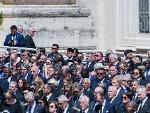Economic growth registered a mere 5.6% increase in the second quarter and only a 5.8% increase in H1, much lower than analysts expected for the second quarter in a row. Fifteen analysts and officials polled by ZF had forecast a 6.1% economic growth rate for the second quarter, but their estimates turned out to be too optimistic for the way the economy is heading.
The economy continues to slow down visibly, from 8.3% in Q3, 2006 to 7.7 in Q4, 2006, and 6% in Q1, 2007 to 5.6% in Q2 of this year. The GDP also continues to lose momentum because of both a slowdown in industrial output and the drought that has already had a serious affect on agriculture.
The publication of figures for the Gross Domestic Product (GDP) by the National Statistics Institute has allowed some new calculations to be made concerning the current account deficit, which is the economy's most problematic indicator. The current account deficit reached an all time high of 16.8% of the GDP in the first half, compared with 10.3% at the end of last year. Calculated for the last four quarters, the foreign deficit stands at 13% of the GDP.
The economic slowdown and the estimated foreign deficit managed to scare yesterday's investors on the forex market. The RON lost a lot of ground against the euro on account of this trend and the exchange rate depreciated at a constant rate throughout yesterday's trading session, from 3.25 to 3.3 RON. The RON's decline started as soon as trading session ended on Monday, when Standard&Poor's rating agency stated that Romania (along with Bulgaria, Turkey and Iceland) were part of the group of European states that would be most affected by a new shortage in global liquidity.
The depreciation of the RON was also brought to attention in a survey conducted by the Swiss bank UBS. This bank's report says that a significant depreciation of the RON cannot be a







